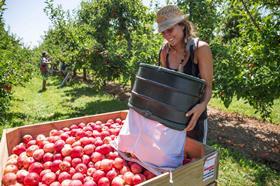
New Zealand’s apple and pear sector has the crop for a bumper export campaign, it just might not have the hands to pick it.
The industry’s peak body, New Zealand Apples and Pears (NZAPI), said the 2022 crop is predicted to reach 601,000 tonnes, with 23.2m cartons(18kg) potentially destined for customers in more than 80 countries.
“Assuming fruit is able to be picked and packed, export volume could be slightly higher than 2020 levels, which dropped (in 2021) following the disastrous Boxing Day hail event in the Nelson region,” a media release from NZAPI said.
Unfortunately for New Zealand suppliers that assumption looks optimistic.
NZAPI chief executive Terry Meiklesaid the Omicron variant was now firmly established in New Zealand, impeding the industry’s ability to pick and pack fruit.
“It will be vital that a pragmatic approach is taken by government to set clear and consistent rules that allow workers to pick, pack and ship the harvest,” said Meikle.
These challenges have been compounded by the arrival of Omicron in Tonga and Samoa, a key source of seasonal labour for the New Zealand apple and pear harvest. The ongoing disaster recovery effort in Tonga following January'svolcanic eruption is also adding to the challenge.
“We are working hard with the New Zealand and Pacific governments, Air New Zealand, our employers and of course our Tongan workers, to return home those in need and bring back those who are ready to return,” Meiklesaid.
“The economic recovery of the Pacific and the success of the New Zealand apple and pear sector are linked. Our horticulture industries are the largest non-government employers of workers from Pacific countries. Remittances will play a huge part in helping the Pacific, particularly Tonga, as it recovers from the eruption and tsunami.”
While NZAPI has thrown its support behind New Zealand’s five stage border re-opening, Meikle said it would be “too little, too late” for the 2022 apple and pear harvest.
In any case, Meikle was optimistic that growers would navigate the complexities of the operating environment and harvest a high-quality crop.
“As always, our growers are focusing on quality first and ensuring a great eating experience for their customers,” Meikle said. “In terms of labour supply and impacts of Omicron, most growers are planning for the worst and hoping for the best.”



